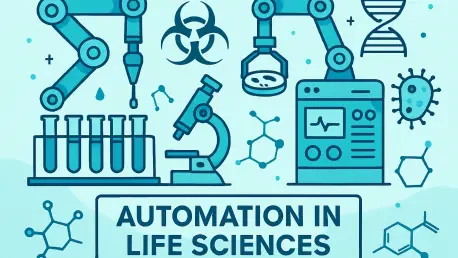In an era where global healthcare demands are skyrocketing due to an aging population and rapid demographic growth, the life sciences sector finds itself at a critical juncture, compelled to innovate to keep pace with unprecedented challenges. Automation has emerged as a game-changer, reshaping how industries such as biotechnology, pharmaceuticals, and medical technology operate. From streamlining laboratory diagnostics to enhancing drug development, automated systems are replacing tedious manual processes with efficient, scalable solutions. This transformation is not merely a trend but a necessity, driven by the urgent need for higher throughput and consistent quality in health-related applications. As companies race to meet these demands, automation stands out as the linchpin for achieving both operational excellence and cost control, paving the way for significant market expansion. The impact of this technological shift is profound, promising to redefine the future of life sciences with innovative approaches and sustainable growth.
Driving Forces Behind Automation Adoption
The surge in automation within life sciences is largely fueled by pressing global demographic shifts that have intensified the need for advanced medical care and testing capabilities. An aging population, coupled with overall growth in numbers worldwide, has placed immense pressure on healthcare systems to deliver faster and more reliable solutions. Automation addresses this by transforming labor-intensive tasks, such as handling vials in laboratories, into streamlined, machine-driven processes. This shift not only boosts productivity but also ensures a level of precision that manual efforts often struggle to maintain. The ability to scale operations without a proportional spike in costs offers a strategic advantage, allowing companies to manage resources effectively while meeting rising expectations. As a result, automation has become a cornerstone for industries aiming to balance efficiency with the stringent quality standards required in health applications, setting a new benchmark for operational success.
Beyond demographics, the push for automation is also driven by the inherent need for consistency and repeatability in life sciences workflows. Manual processes, while still prevalent in certain areas, are prone to human error, which can compromise outcomes in critical fields like pharmaceuticals and diagnostics. Automated systems mitigate these risks by standardizing procedures, ensuring that each step—from sample analysis to production—is executed with unwavering accuracy. This reliability is particularly vital in environments where even minor discrepancies can have significant consequences. Furthermore, automation enables faster turnaround times, accelerating the development of medical technologies and treatments that are urgently needed. By integrating advanced technologies, the sector can respond more swiftly to emerging health challenges, reinforcing the indispensable role of automation in shaping a resilient and responsive industry ready to tackle future demands.
Innovative Solutions Fueling Market Expansion
A pivotal player in this transformation is the strategic application of industrial automation expertise to life sciences challenges, exemplified by tailored solutions developed for laboratory and medical technology processes. Specialized divisions in leading automation companies have honed pneumatic and electric systems designed specifically for the unique needs of this sector. These innovations, often engineered in global hubs across regions like North America, Europe, and Asia, ensure adaptability to diverse market requirements. By mimicking high-efficiency production line setups, such solutions minimize human intervention, reducing errors while significantly speeding up operations. This cross-industry approach not only enhances throughput but also fosters a new wave of technological advancements, such as linear motion and gripper systems, which improve testing speeds and application outcomes. The result is a robust framework that supports sustained market growth through cutting-edge automation.
Equally important is the role of these tailored solutions in addressing cost management, a persistent concern for life sciences companies navigating tight budgets and regulatory pressures. Automation offers a pathway to perform more work without incurring proportional expenses, a critical factor in maintaining competitiveness. Advanced systems streamline complex processes, from drug formulation to diagnostic testing, ensuring that quality remains uncompromised even as output scales. This efficiency translates into tangible market opportunities, as firms can allocate resources to innovation rather than labor-intensive tasks. Moreover, the adaptability of automation technologies to regional needs ensures that solutions are not one-size-fits-all but are instead customized for maximum impact. As the sector continues to evolve, these advancements lay the groundwork for a future where automation drives not just operational success but also broader accessibility to life-saving technologies.
Reflecting on a Path of Progress
Looking back, the journey of automation in life sciences reveals a remarkable shift, as manual processes gradually gave way to sophisticated, technology-driven systems that redefined efficiency and quality. The adoption of automation tackled critical challenges posed by demographic pressures, delivering consistent results where precision was paramount. Strategic innovations, crafted through global collaboration, played a vital role in meeting diverse market needs, ensuring that solutions were both effective and adaptable. As the industry navigated cost constraints, automation proved to be a powerful ally, enabling scalability without sacrificing standards. Moving forward, the focus should center on further integrating emerging technologies to address evolving health demands while fostering partnerships that drive innovation. Exploring ways to make automation accessible across all scales of operation will be key, ensuring that even smaller players can contribute to and benefit from this transformative wave in life sciences.









